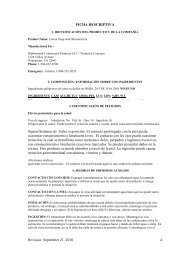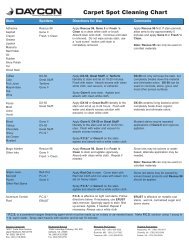Material Safety Data Sheet - Daycon
Material Safety Data Sheet - Daycon
Material Safety Data Sheet - Daycon
You also want an ePaper? Increase the reach of your titles
YUMPU automatically turns print PDFs into web optimized ePapers that Google loves.
Incompatibility (<strong>Material</strong>s to Avoid)<br />
Avoid strong oxidizing agents.<br />
Hazardous Products Produced During Decomposition<br />
Oxides of carbon.<br />
Hazardous Polymerization? (Mark May Occur<br />
an X next to the ones that apply)<br />
Stability? (Mark an X next to the<br />
ones that apply)<br />
Stable<br />
×<br />
10. Stability and Reactivity<br />
Will Not Occur<br />
×<br />
Unstable<br />
Conditions to Avoid<br />
N/A<br />
Conditions to Avoid<br />
Contact with Aluminum Chloride polymerization catalyst,<br />
strong oxidizing agents.<br />
11. Toxicological Information<br />
Toxicity <strong>Data</strong>, Epidemiology Studies, Carcinogenicity, Neurological Effects, Genetic Effects, Reproductive Effects, or Structure Activity <strong>Data</strong><br />
For D-Limonene:<br />
LD50/LC50:<br />
CAS# 5989-27-5:<br />
Draize test, rabbit, skin: 10%/24H Mild;<br />
Oral, mouse: LD50 = 5600 mg/kg;<br />
Oral, rat: LD50 = 4400 mg/kg;<br />
Skin, rabbit: LD50 = >5 gm/kg; .<br />
Carcinogenicity:CAS# 5989-27-5: Not listed by ACGIH, IARC, NTP, or CA Prop 65.<br />
Epidemiology: No information available.<br />
Teratogenicity: Not known to be teratogenic.<br />
Reproductive Effects: See actual entry in RTECS for complete information.<br />
Mutagenicity: d-Limonene was not mutagenic in 4 strains of S. typhimurium, did not significantly increase the<br />
number of Tft-resistant cells in the mouse L5178Y/TK+/- assay, and did not induce chromosomal aberrations or<br />
SCEs in cultured CHO cells.<br />
Neurotoxicity: No information available.<br />
12. Ecological Information<br />
Toxicity, Environmental Fate, Physical/Chemical <strong>Data</strong>, or Other <strong>Data</strong> Supporting Environmental Hazard Statements<br />
For D-Limonene:<br />
Ecotoxicity: No data available. No information available.<br />
Environmental: May bioconcentrate in aquatic organisms and fish. Has low mobility in soil and may rapidly<br />
volatilize in the atmosphere. Limonene can be readily degraded in soil.<br />
Physical: No information available.<br />
Other: Dipentene, which is optically inactive limonene, is a marine pollutant.<br />
13. Disposal Considerations<br />
Regulations<br />
Chemical waste generators must determine whether a discarded chemical is classified as a hazardous waste. US<br />
EPA guidelines for the classification determination are listed in 40 CFR Parts 261.3. Additionally, waste generators<br />
must consult state and local hazardous waste regulations to ensure complete and accurate classification.<br />
RCRA P-Series: None listed.<br />
RCRA U-Series: None listed.<br />
Properties (Physical/Chemical) Affecting Disposal<br />
Combustible<br />
NOTE: State or local requirements may differ from federal regulations. Processing or using this product may make the information here inappropriate. Waste<br />
generators are responsible for waste classification, transport, and disposal.<br />
MSDS 105 RESCUE 96 Page 4 138-F 2013




